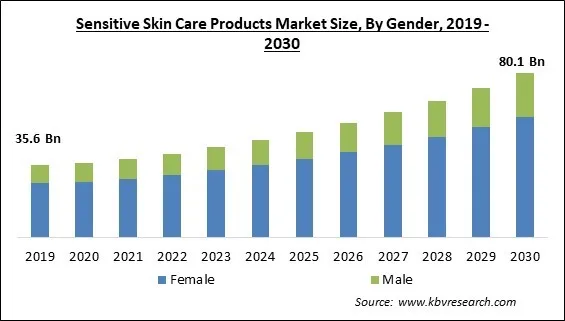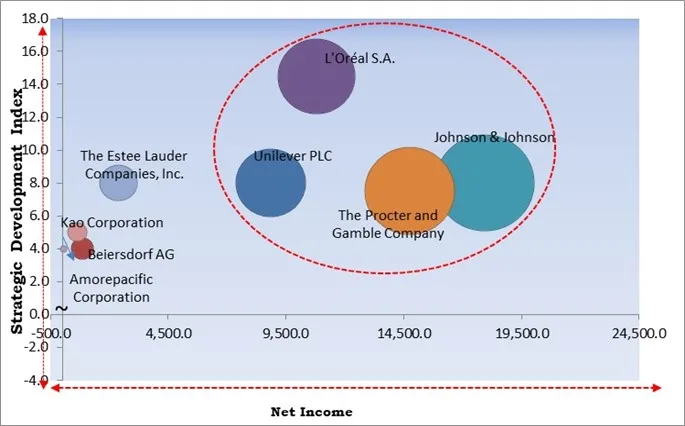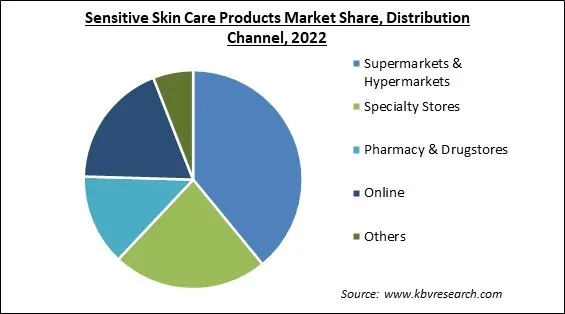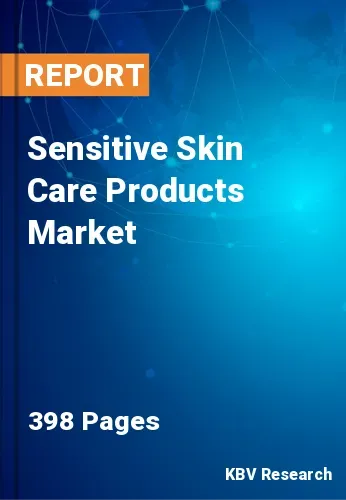The Global Sensitive Skin Care Products Market size is expected to reach $80.1 billion by 2030, rising at a market growth of 8.9% CAGR during the forecast period.
Face creams and moisturizers are some of the products that are employed the most because they are regularly utilized. Therefore, face creams and moisturizers generated $8,542.3 million revenue in the market in 2022. Moisturizers are a simple, hassle-free, fast method to treat dry skin in addition to providing advantages including rapid hydration, less breakouts, and revitalized skin. Additionally, as more people choose cruelty-free skincare products because they are more concerned about animal welfare and the environment, there is a growing market for vegan or skincare products that contain a combination of plant-based components.

The major strategies followed by the market participants are Acquisitions as the key developmental strategy to keep pace with the changing demands of end users. For example, In February, 2022, Beiersdorf acquired Chantecaille Beaute offering in prominence beauty with creative skincare, fragrance, and cosmetics products that are based on botanical ingredients. The new brand would further boost Beiersdorf's growth in the Asian and North American markets. Additionally, In September, 2022, L’Oréal signed an agreement to acquire Skinbetter Science aligns with the Active Cosmetics Division’s brand offerings. This would contribute highly to the L’Oréal Active Cosmetics Division’s aim to lead in health and beauty segments with advanced science-based skincare innovations.
Based on the Analysis presented in the KBV Cardinal matrix; L'Oréal S.A., Johnson & Johnson, Unilever PLC, and The Procter and Gamble Company are the forerunners in the Sensitive Skin Care Products Market. In April, 2023, L'Oréal came into an agreement with Natura & Co to acquire Aesop, the luxury Australian skincare brand. Through this acquisition, L’Oréal would increase its footprint in the high-end, natural beauty product area and broaden its presence across China. Companies such as The Estee Lauder Companies, Inc., Kao Corporation and Beiersdorf AG are some of the key innovators in Sensitive Skin Care Products Market.

Customers in emerging nations favor imported cosmetics over those created locally. Most people in these nations favor international brands because of the high quality and accessibility of these products. Due to growing consumer interest in skincare and increasing disposable income, there is an increased demand for imported luxury and niche brands of sensitive skincare products. The market for sensitive skin care products is thus being stimulated by this.
The market for sensitive skin care products is anticipated to be driven by the increased demand for natural & organic personal care products due to growing health concerns. These are frequently made from plants, ensuring that the skin benefits more from all of the natural ingredients used to make the product. The demand for sun care products has increased due to the increasing prevalence of skin cancer and other skin issues, and it is anticipated to continue to do so during the forecasted period. These products multifaceted skin protection qualities are also helping them become more well-liked by consumers. The market for sensitive skin care products is expected to increase due to all these factors over the projected period.
Due to the extensive availability of counterfeit skin care products, consumers are intuitively urged to buy low-quality, not branded skincare items instead of reputable brands. As a result, users may purchase skin care products that contain substances that are potentially dangerous to their health. In addition, using these items creates unfavorable skin conditions, such as rashes, skin wrinkles, and swelling, that decreases the desire of consumers to purchase extra skin care products, thus limiting the market's potential for growth. Furthermore, the more expensive cost of luxury skin care products affects the need for these products among individuals with lower incomes, thereby impeding the growth of the market for sensitive skin care products.
By gender, the sensitive skin care products market is fragmented into male, and female. In 2022, the female segment witnessed the largest revenue share in the sensitive skin care products market. Female consumers' need for sensitive skin care products has been fueled by growing knowledge of skin sensitivities and the value of proper skincare. Additionally, many companies offer a variety of goods that appeal to the needs of women, like acne control, hydration, anti-aging, or sun protection, to reach a wider audience. During the anticipated period, this is anticipated to fuel market growth.
On the basis of distribution channel, the sensitive skin care products market is categorized into supermarkets & hypermarkets, specialty stores, pharmacy & drugstores, online, and others. In 2022, the online segment recorded a remarkable revenue share in the sensitive skin care products market. Consumers now purchase body sensitive care goods in a different way because to the growth of e-commerce or direct-to-consumer business methods. Online platforms make it easy and convenient for customers to do their research, compare items, read reviews, and then make decisions.

Based on product, the sensitive skin care market is segmented into face care, body care and lip care. In 2022, the face care segment registered the largest revenue share in the sensitive skin care products market. The demand from consumers for items to care for their faces has significantly increased. The need for specialist products designed for sensitive facial skin has increased as a result of factors such as greater awareness of skin sensitivities, changing lifestyles, and an increasing focus on skincare routines.
| Report Attribute | Details |
|---|---|
| Market size value in 2022 | USD 40.9 Billion |
| Market size forecast in 2030 | USD 80.1 Billion |
| Base Year | 2022 |
| Historical Period | 2019 to 2021 |
| Forecast Period | 2023 to 2030 |
| Revenue Growth Rate | CAGR of 8.9% from 2023 to 2030 |
| Number of Pages | 398 |
| Number of Table | 654 |
| Report coverage | Market Trends, Revenue Estimation and Forecast, Segmentation Analysis, Regional and Country Breakdown, Companies Strategic Developments, Company Profiling |
| Segments covered | Gender, Distribution Channel, Product, Region |
| Country scope | US, Canada, Mexico, Germany, UK, France, Russia, Spain, Italy, China, Japan, India, South Korea, Singapore, Malaysia, Brazil, Argentina, UAE, Saudi Arabia, South Africa, Nigeria |
| Growth Drivers |
|
| Restraints |
|
Region wise, the sensitive skin care products market is analyzed across North America, Europe, Asia Pacific, and LAMEA. In 2022, the APAC region led the sensitive skin care products market by generating the highest revenue share. The region's sensitive skin care products market is growing due to elements like population expansion, escalating urbanization, and increasing per capita spending on personal care products in developing nations like South Korea, China, India, and Indonesia. Additionally, nearly one-third of Chinese shoppers said they'd be prepared to shell out more money for a sheet mask perfect for their sensitive skin.
Free Valuable Insights: Global Sensitive Skin Care Products Market size to reach USD 80.1 Billion by 2030
The market research report covers the analysis of key stake holders of the market. Key companies profiled in the report include L'Oréal S.A., Johnson & Johnson, Unilever PLC, Beiersdorf AG, The Estee Lauder Companies, Inc., The Procter and Gamble Company, Amorepacific Corporation, Kao Corporation, Pevonia International LLC, and Sebapharma GmbH & Co. KG.
By Gender
By Distribution Channel
By Product
By Geography


The Market size is projected to reach USD 80.1 billion by 2030.
Rising demand for natural & organic care products are driving the Market in coming years, however, Growing marketing of counterfeit products restraints the growth of the Market.
L'Oréal S.A., Johnson & Johnson, Unilever PLC, Beiersdorf AG, The Estee Lauder Companies, Inc., The Procter and Gamble Company, Amorepacific Corporation, Kao Corporation, Pevonia International LLC, and Sebapharma GmbH & Co. KG.
The Supermarkets & Hypermarkets segment acquired the highest revenue share in the Products Market by Distribution Channel in 2022, thereby achieving a market value of $29.8 billion by 2030.
The Body Care segment has shown a high growth rate of 9.2% during (2023 - 2030).
The Asia Pacific region dominated the Market by Region in 2022, and would continue to be a dominant market till 2030; thereby, achieving a market value of $32.2 billion by 2030, growing at a CAGR of 9.3 % during the forecast period.
Our team of dedicated experts can provide you with attractive expansion opportunities for your business.

